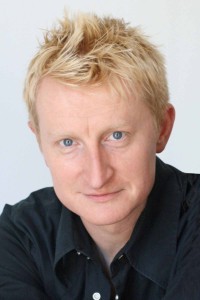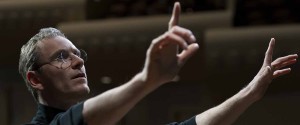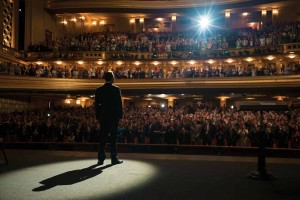![]()

The challenge for Guy Hendrix Dyas, the film’s production designer, was to recreate the three settings, differentiating them in terms of their look and period feel, over a span of less than 15 years.
The auditoriums where the rollouts took place were used as locations, with some liberties taken to add psychological dimensions to the spaces. “To keep it visually interesting and also to show the progression in who Steve Jobs was as a person and to show his influence in the world, we twisted the venues a bit to suit the thread of our story,” said Dyas.

“Color was going to serve as my way of delineating the acts,” said Dyas. “Thumb through any historical materials, and there will be leading colors that stand out in fashion, architecture and culture in any period. Color would be both the barometer of the time and the indicator of the place.”
In the early ’80s, America still had this late 1970s hangover in terms of interiors and color sensibilities, he observed. “We used late 1970s colors like mustard and green to dress and paint Flint Hall which worked well to show that in contrast the Macintosh was a thing of the future.” The Opera House with its dominant red interior where the NeXT gets shown, “was the perfect venue for the drama and passion of what is really an act of revenge for Steve, using his new computer almost like a stalking horse to pave his way back to Apple,” said the production designer. With Jobs firmly ensconced again as the head of Apple, the Symphony Hall setting is more modern and in line with the futuristic iMac.
 In addition to the real location venues, about one-third of the action takes place backstage, and that was shot on sets. “Every time the actors walk off stage and turn a corner, they are basically on a set,” noted Dyas. “Those sets were used for the extensive and complicated dialogue scenes written by Aaron. One of things Danny Boyle said at the beginning of production, Dyas recalled, was that while in Social Network (the movie about Mark Zuckerberg’s founding of Facebook which Sorkin also scripted) the dialogue takes place where people are mainly sitting down. “Danny wanted Steve Jobs to have characters delivering dialogue while standing and walking around and I and my team had to create those spaces,” he said.
In addition to the real location venues, about one-third of the action takes place backstage, and that was shot on sets. “Every time the actors walk off stage and turn a corner, they are basically on a set,” noted Dyas. “Those sets were used for the extensive and complicated dialogue scenes written by Aaron. One of things Danny Boyle said at the beginning of production, Dyas recalled, was that while in Social Network (the movie about Mark Zuckerberg’s founding of Facebook which Sorkin also scripted) the dialogue takes place where people are mainly sitting down. “Danny wanted Steve Jobs to have characters delivering dialogue while standing and walking around and I and my team had to create those spaces,” he said.
The present-at-the-creation scenes were shot in Jobs’ real garage where he and Steve Wozniak built the first Apple. Dyas credited the dead-on recreation of the delightfully jumbled interior, modeled on actual pictures, to his expert set decorator Gene Serdena, who has worked on films like Her for director Spike Jonze and on David O. Russell’s The Fighter.
An example of how punctilious Dyas can be was when he found the actual location to set a scene where Jobs is sitting cross-legged on a wooden floor deep in thought. The now famous image originally appeared on the cover of Time Magazine. No previous Jobs movie had discovered where this had taken place, but the production designer while rummaging around in the original garage, fund a blueprint for an early Apple that had an address scrawled on it. And, on an inkling, he tasked his location manager find the house.
The current owner gave permission to use the room. Dyas and Serdena replicated the Tiffany lamp, the stereo and even some albums that were in the original photograph. Fassbender’s Jobs then was filmed in the same cross-legged pose. “It was eerie, almost like we were right there with Steve,” said the production designer.
“It’s really special when you actually get to work in and around American city that is correctly suited for the material. That to me was the magic of Steve Jobs,” he concluded. “The fact that Danny and Aaron Sorkin fought all the powers that be to shoot in San Francisco and in California, despite constant pressure to shoot other than the place where the computer industry was born, was extremely intense. But Danny held his own. I have to say it really paid off in the end.”
Some of Dyas’ previous film credits include Elizabeth: The Golden Age, Indiana Jones and the Crystal Skull and Inception. He is currently working on Passenger, about a space journey, starring Jennifer Lawrence and Chris Pratt and directed by Morten Tyldum who did The Imitation Game. “It’s the largest set I’ve ever had to create,” the English production designer exhaled.





